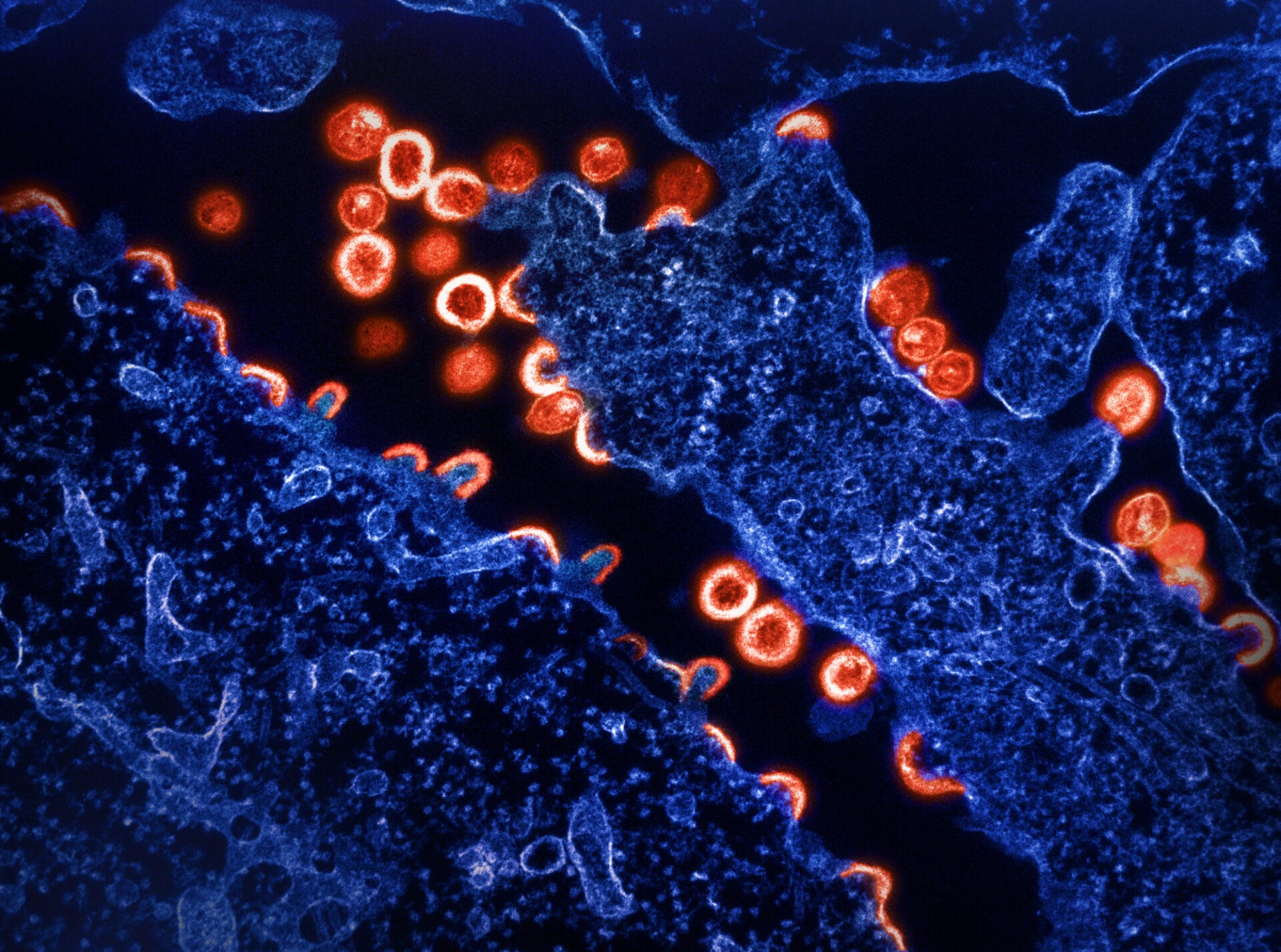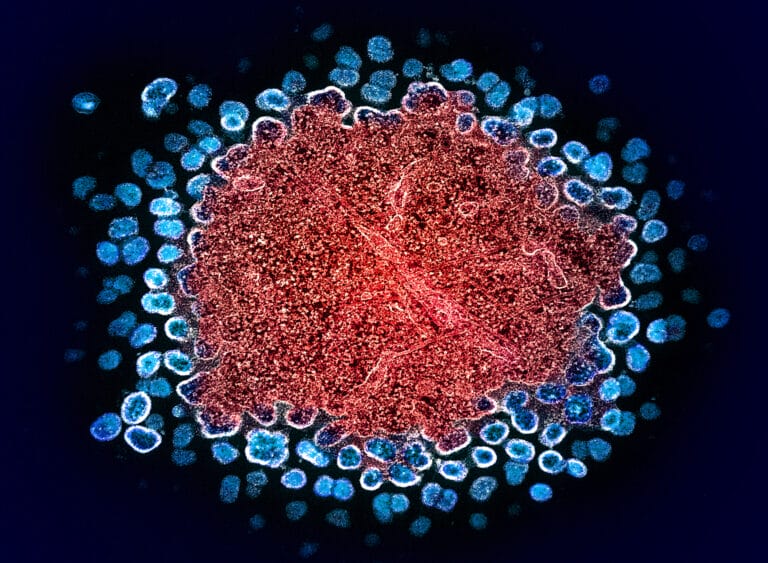What is HIV?
Image credit: NIAID / via WikiMedia Commons

HIV is a virus that attacks the immune system. If left untreated, it can cause AIDS.
- Human immunodeficiency virus (HIV) is a virus that infects humans and attacks the immune system.
- The final stage of HIV infection is acquired immunodeficiency syndrome (AIDS), which can be life-threatening.
- There is currently no cure for HIV, but infections can be managed through regular clinical monitoring and antiretroviral treatments.
What is HIV?
- HIV, or human immunodeficiency virus, is a virus that damages the cells of the immune system, weakening its ability to fight everyday infections.
- Specifically, HIV attacks the CD4 T-cells, which are key immune cells involved in fighting infection and disease.
- Destroying these immune cells leaves individuals open to various infections and the development of certain cancers.
What is AIDS?
- Acquired immunodeficiency syndrome (AIDS) is the final stage of HIV infection. This is when the immune system has been diminished to the point that the body can no longer fight life-threatening infections.
- People who have HIV are diagnosed with AIDS when their CD4 T-cell count is very low:
- a normal CD4 count ranges from 500-1,000 CD4 T-cells/mm3
- a CD4 count of fewer than 200 CD4 T-cells/mm3 qualifies for a diagnosis of AIDS.
- With early detection of HIV and modern treatments for the infection, HIV infections can be managed to avoid them progressing to AIDS.
- For example, antiretroviral therapy (or ART) suppresses the replication of the virus inside the body. This allows the immune system to repair itself and prevent further damage.

How is HIV transmitted?
- HIV is found in some bodily fluids and can be transmitted:
- through unprotected sex
- by sharing of needles used to inject drugs
- from an HIV-positive mother to her child during childbirth or breast feeding.
- HIV cannot be spread through sweat, urine or touching an infected person.
- If a person with HIV is taking antiretroviral treatment, their virus levels (‘viral load’) can be reduced to be so low that the virus cannot be passed on. This is sometimes called ‘U=U’, for ‘undetectable = untransmissible’.
- Most people taking HIV treatment reach ‘U=U’ within six months of starting the treatment.
What are the symptoms of HIV?
Symptoms of HIV vary depending on the individual and the stage of HIV infection.
Early stage
- 2-4 weeks after infection, people with HIV tend to display flu-like symptoms, such as fever, swollen glands and sore throat.
- This is the body’s natural response to the HIV infection as it tries to fight it off.
- Generally, this stage lasts from a few days to several weeks.
Latent stage
- The disease moves into a ‘latency’ period where the virus continues to grow in the individual but without causing any symptoms.
- If the infection is left untreated, the latent period lasts an average of 10 years in people with HIV.
- For individuals given antiretroviral therapy (ART), the latent stage may last for several decades because this treatment helps to keep the virus under control, preventing it from progressing to the next stage, AIDS.
Progression to AIDS
- If an individual is not taking any medication for their HIV, the virus will eventually weaken the body’s immune system to the point that symptoms arise again.
- Symptoms are much more profound than in the early stage and include rapid weight loss, extreme tiredness and memory loss.
- This stage of HIV infection also leaves the body vulnerable to ‘opportunistic’ infections, which take advantage of the body’s weakened immune state.
- Opportunistic infections can be localised (meaning they only affect one part of the body) or systemic (meaning they have spread to other parts of the body).
- Examples of opportunistic infections include:
- Tuberculosis (TB): for people living with HIV, tuberculosis infections are very serious and are the leading cause of death. This is because people with HIV have a weakened immune system, so tuberculosis infections can quickly develop into disease if left untreated.
- Kaposi’s sarcoma: is a rare form of cancer caused by human herpesvirus 8. Sarcomas develop primarily in the muscle, bone, nerves, tendons, blood vessels and fatty and fibrous tissue. Kaposi’s sarcoma appears as red or purple lesions on the body and in the mouth but can also damage internal organs. Treatment includes surgery to remove small skin lesions or chemotherapy and radiotherapy if the disease has progressed.
- Toxoplasmosis: is caused by the parasite Toxoplasma gondii, which is carried by cats and birds. It can cause mild flu-like symptoms but can also cause serious problems in the brain and eyes in HIV patients with low CD4 T-cell counts.
- Cytomegalovirus (CMV): is a human herpesvirus that is transmitted in bodily fluids and in most cases causes no symptoms or flu-like symptoms. Once infected, the virus never leaves the body but can re-emerge if the immune system is weakened. It can affect the eyes, lungs and digestive system causing inflammation.
- If a person with HIV develops one or more of these opportunistic infections, it may indicate that their HIV infection has progressed to AIDS.
How is HIV managed?
- If a person has been exposed to HIV, it’s possible to take post-exposure prophylaxis (PEP) to stop the infection. This must be taken within 72 hours of exposure to be effective.
- There is currently no cure for HIV, but infections can be managed through regular clinical monitoring and antiretroviral treatments.
- These treatments control the HIV infection and prevent it progressing to AIDS.
- HIV-infected people who manage their infections with antiretroviral treatments are able to live long and healthy lives.